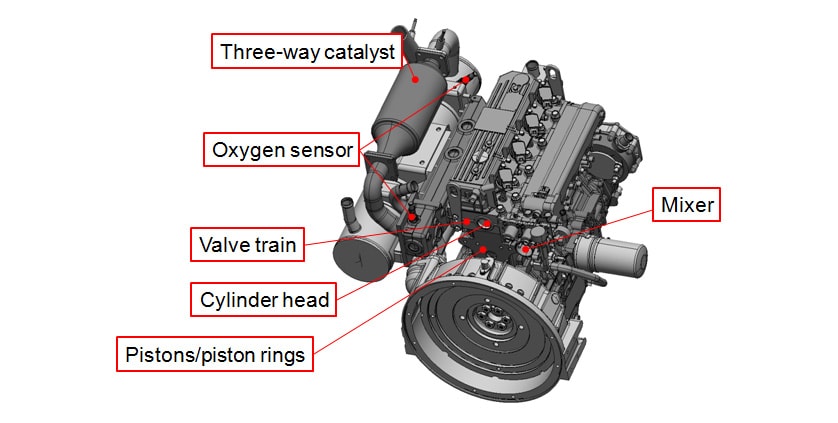Engine Development Division
Industrial Power Products Management Division
Power Solution Business
YANMAR Technical Review
Technologies Used in Emission Regulation Compliant Stoichiometric Combustion Gas Engines for Micro Co-Generation
Abstract
Yanmar has completed development of its new 4GP98S series of 40 kW class gas engines and the new models have commenced production for use in micro co-generation. The new gas engine uses stoichiometric combustion and a three-way catalyst to satisfy market and customer requirements. Stoichiometric combustion enables higher output relative to engine displacement than Yanmar's previous small gas engines, while use of the three-way catalyst removes more than 90% of CO, NOX, and HC emissions. Other features include improvements to the cylinder head and piston, and precision control of the fuel supply system. These technologies enable the 4GP98S series to satisfy both customer requirements and strict exhaust gas emission regulations, thereby expanding the potential markets for the new models.
1. Introduction
Micro co-generation systems achieve a high level of overall efficiency by using exhaust heat to recover the energy from fuel in the form of heat (hot water) as well as in the form of electric power. Micro co-generation can also be used to reduce use of grid power, both cutting costs by reducing contracted electric power and being available to help maintain the user's business continuity in the event of an emergency. This ability to reduce costs through energy efficiency while improving security of electric power supply has led to micro co-generation being adopted by energy users across a variety of industries, including in hospitals, restaurants, shops, and factories.
Yanmar has developed its new 4GP98S series of gas engines for micro co-generation, which entered mass production on the following dates.
Mass production dates
For North America: From December 2015
For Japan: From March 2016
This article describes the features of the new gas engines together with the technologies adopted to satisfy customer requirements and comply with emission regulations. The customer requirements and emission regulations are listed below.
Customer requirements and emission regulation
(1) Compliance with emission regulations (Japan, North America)
(2) System downsizing
(3) Higher output (improve output relative to engine displacement)
(4) Maintain reliability
Compliance with the relevant emission regulations is essential for encouraging more customers to choose micro co-generation systems with 4GP98S series gas engines. In the case of North America, where demand is expected to grow by the shale gas revolution, this means complying with EPA emission regulations that are far stricter than those in Japan. Furthermore, because micro co-generation systems must be capable of both outdoor and indoor installation, there is a need to make them smaller to facilitate easier on-site delivery and to reduce their installation footprint. To satisfy customer energy demand, it is also vital to do this in a way that does not compromise existing levels of output and reliability.
While past Yanmar gas engines for micro co-generation have used lean combustion, which is advantageous to durability, the 4GP98S series uses stoichiometric combustion to satisfy requirements (2) for system downsizing and (3) for higher output. To achieve compliance with the North American EPA emission regulations (requirement (1)), the 4GP98S series also uses a three-way catalyst in place of the oxidation catalyst used on the previous series.
To ensure reliability (requirement (4)), modifications were also made to the cylinder head and piston parts, which are exposed to the heat and cylinder pressures associated with the new combustion method.
2. Product Overview
Fig. 1 shows Yanmar's range of gas engines for micro co-generation, including the 4GP98S series described in this article.

In developing the 4GP98S series, Yanmar succeeded in producing a 3.3L-class engine that could deliver the same range of outputs as its previous 4.4L-class models (the 4GPF106 series). In doing so, it satisfied customer demand for system downsizing, facilitating easier on-site delivery and reducing the system's installation footprint. As the first gas engine in the 40kW class for Yanmar to satisfy the EPA emission regulations, the 4GP98S series also expanded the company's target market to cover a larger number of potential customers.
Fig. 2 shows an external view of the 4GP98S. Along with the adoption of stoichiometric combustion and the three-way catalyst, the cylinder head, piston parts, and fuel system components as well as the exhaust after treatment parts were fully modified.

3. Technologies
3.1. Stoichiometric Combustion
As described above, the 4GP98S series newly employed stoichiometric combustion.
The lean combustion used on Yanmar's previous small gas engines intakes air into the cylinder with more than the theoretical volume required for combustion. In contrast, stoichiometric combustion can supply more fuel into the cylinder mixed with the exact theoretical volume of air (see Fig. 3), resulting a higher output for a given engine displacement.
The disadvantage of stoichiometric combustion is that it exposes engine components to greater thermal and mechanical loads than lean combustion. To improve this, the following three main modifications were made to the 4GP98S series to ensure achieving the same level of reliability and product life as previous models.

Main countermeasures against thermal and mechanical load
(1) Improvements to cylinder head cooling
(2) Optimization of materials used in valve train
(3) Modification of piston structure
As shown in Fig. 4, a CAE analysis of these modifications was performed to verify their performance prior to testing on an actual engine. This made it possible to achieve the level of reliability demanded by customers in a short period of time.

3.2. Three-Way Catalyst
As shown in Fig. 5, the three-way catalyst can remove 90% or more of NOX, CO, and HC emissions under the theoretical equivalent ratio (stoichiometric) condition. The specifications for the three-way catalyst were determined to satisfy the emission levels stipulated by the regulations based on the use of stoichiometric combustion and associated parts modifications described above. As shown in Fig. 2, the 4GP98S series has oxygen sensors upstream and downstream of the three-way catalyst and use feedback control for the fuel system components to keep the mixture in a very narrow window around the stoichiometric condition. By taking advantage of the oxygen storage capability of the co-catalyst included in the three-way catalyst, this maintains a high level of exhaust gas purification performance. Through this optimal combination of hardware and software, compliance with EPA emission regulations was achieved.

4. Product Features
4.1. Environmental Performance
Fig. 6 shows a graph of actual emission performance. The lean combustion used in previous models exceeded EPA limits for NMHC+NOX. On the new model, the combination of stoichiometric combustion and three-way catalyst significantly reduces NMHC+NOX, making the 4GP98S series the first small gas engine model able to enter the North American market in the 19kW or higher output range. The 4GP98S series also features enhanced environmental performance, with an increase in the overall efficiency of the micro co-generation package by approximately three percentage point (85% → 88%) compared to previous models, thanks to the higher exhaust gas temperature associated with stoichiometric combustion.

4.2. Downsizing
The change from lean to stoichiometric combustion increased specific output to the extent that a 3.3L-class engine can deliver the same output as previous 4.4L-class engines (35kW electric power generation), as indicated in Fig. 1. This enables the installation footprint of a micro co-generation package to be reduced by 27% compared to systems with a 4.4L-class engine (see Fig. 7), with the smaller space requirement offering major benefits for customers.

4.3. Longer Product Life
The greater thermal and mechanical loads associated with the switch to stoichiometric combustion raise concerns about the durability of cylinder heads, pistons, and valve trains. In response, by adopting the measures described in section 3.1, Yanmar can offer a long product life that helps reduce the life cycle cost to customers.
5. Conclusions
Yanmar has developed its 4GP98S gas engine for the North American and Japanese micro co-generation markets. The switch from lean to stoichiometric combustion satisfies customer demands for higher output and downsizing while the adoption of a three-way catalyst enables the engine to comply with EPA emission regulations, expanding the potential market for Yanmar's products to encompass a larger number of customers.
The adoption of these technologies is one way in which Yanmar hopes to continue helping society to become more energy efficient through its small gas engines.
Finally, the authors would like to express their sincere thanks to everyone who provided considerable support and assistance during the development of the 4GP98S series of engines.
-IMPORTANT-
The original technical report is written in Japanese.
This document was translated by Research & Development Management Division.
Author


Engine Development Division
Industrial Power Products Management Division
Power Solution Business